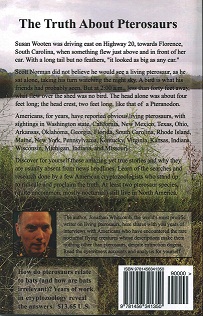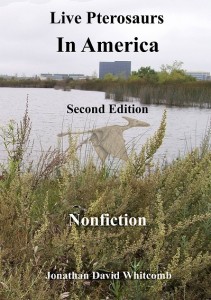As of late-2010, only a few of the scientists who had investigated Marfa Lights, the strange ghost lights of Marfa, Texas, had been informed of the living-pterosaur explanation. (Not all lights around Marfa are truly uncommon, however, since the atmospheric conditions sometimes make distant car headlights appear strange.) The cryptozoological possibility seems weird, but there are similarities with the ropen lights of Papua New Guinea, and there the lights are said to be nocturnal flying creatures described like giant Rhamphorhynchoid pterosaurs: long-tailed ropens.
Sightings of Marfa Lights in Texas
. . . there is a separate and unique light phenomenon in the area of the Chianati mountain range that I can not explain. Balls of light sitting in a chico bush . . . One I really enjoyed watching moved straight up a cliff face and then rested on top of the mountain changing from bright yellow to a dim red . . .
The flying (and sometimes dancing) lights of Marfa, Texas, only show themselves a few times a year, in contrast to the counterfeit “strange” lights caused by headlights of cars on a nearby highway. But if those lights are caused by the same general kind of creature as the ropen of Papua New Guinea (large or giant featherless flying creature with a long tail) . . .
Addendum
Late in November, 2010, was published the second edition of the cryptozoology book Live Pterosaurs in America, with one chapter devoted to the mystery of the Marfa Lights and the interpretation of ropen-like bioluminescent flying predators. This extraordinary possibility of living pterosaurs in southwest Texas makes serious scientific investigations worth the effort, even if the bioluminescent predator is eventually found to be only a bird or a bat.
Early in December, 2010, a press release about the Marfa Lights, “Unmasking a Flying Predator in Texas,” spread across the United States, mostly through online news sites. For some readers, this was their first exposure to the possibility of bioluminescent pterosaurs (AKA “pterodactyls”) flying over southwest Texas at night. That press release deals with the specifics of a particular kind of mystery-light sighting: splittings and re-mergings of flying lights, and the potential for bioluminescence in huning bats that catch insects.
When residents of Marfa, Texas, and those in surrounding areas . . . have observed the more mysterious flying lights—many observations over the decades—they recognize an intelligence in the “dances.” A light sometimes will split into two lights and the two will slowly separate for quite a distance, eventually turning back as they approach each other, like in a square dance . . .
__________________________________________________________________________
 From Chapter Six of the second edition of the cryptozoology book Live Pterosaurs in America:
From Chapter Six of the second edition of the cryptozoology book Live Pterosaurs in America:
“Mr. Bunnell the scientist, has lived around Marfa, Texas, for much of his life. In his youth, he had assumed that somebody had already done the research and had explained what caused Marfa Lights, for people had seen them for countless years; how surprising when he found that nobody had come up with a convincing explanation! (James Bunnell, apparently, knew nothing about ropens in New Guinea; he considered only Marfa Lights interpretations involving light-sources non-living. I communicated with him by emails, early in 2010.)”
Read about this amazing new cryptozoological interpretation of the Marfa Lights of Texas.
__________________________________________________________________________
 Second edition of Live Pterosaurs in America, nonfiction cryptozoology book by Jonathan David Whitcomb
Second edition of Live Pterosaurs in America, nonfiction cryptozoology book by Jonathan David Whitcomb
Published by Createspace, November 20, 2010
146 pages, with an extensive index for researchers
ISBN-13: 9781456341350
“Scott Norman did not believe he would see a living pterosaur, as he sat alone, taking his turn watching the night sky. A bird is what his friends had probably seen. But at 2:00 a.m., less than forty feet away, what flew over the shed was no bird. The head alone was about four feet long; the head crest, two feet long, like that of a Pteranodon.”



I admit I have not been certain that the Marfa Lights are caused by bioluminescent pterosaurs like the ropen of Papua New Guinea. But throughout 2010, I have become about 70% sure that this is what they are. Eyewitnesses in both Papua New Guinea and in Texas have seen large pterosaur-like flying creatures; they have also seen strange lights that are known by natives of Papua New Guinea to be caused by those large flying creatures. And Marfa Lights sometimes behave far too much like intelligent creatures to be from non-living things like tectonic stress or ball lightning.
In a newspaper article (mid-Dec, 2010, Houston Chronicle), Karl Stephan, an engineering professor at Texas State University, was quoted: “I encourage Mr. Whitcomb to come to Marfa and spend six months there before he says anything more about dinosaurs.”
Actually, I said nothing about dinosaurs in southwest Texas. The writer of the article caught hold of “flying dinosaurs” and got carried away with the word “dinosaur.” The correct word is “pterosaur.” Those who have read much of my own writing (rather than read only what others write about my ideas) know that I call the creatures “pterosaurs.”
Mr. Stephan’s invitation-request sounds almost reasonable, on the surface. But do we really need one more Californian at the Marfa Lights Viewing Platform, searching the night skies, night after night, hoping for a distant sighting of a Marfa Light? No. We need more clear thinking and more careful scientific analysis, with an open mind to the biological possibility (Mr. Stephan is not a biologist). We need to recognize characteristics of ML-CE-III’s that suggest bioluminescent flying predators. And we need to look past the bias that comes from the tragic indoctrination that we Americans have been subjected to: universal-extinction dogma for dinosaurs and pterosaurs.
Although Mr. James Bunnell, when he first learned about the biological interpretation possibility for Marfa Lights, assumed it was impossible, he is not a biologist. He has worked on these mystery lights, for years, with the assumption that they are caused by non-living energies. He admits that they are very mysterious, but has not yet, as far as I know (as of late 2010), admitted that some of the behaviors of the ML-CE-III type suggest an intelligent direction to the flights of those lights. Residents notice this intelligence instinctively, even labeling the lights with things like “dancing devils.”
Even if the CE-III’s are not from living pterosaurs like the ropen of Papua New Guinea, they seem to be from some kind of flying predator, bioluminescent but much bigger than fireflies.
It has just come out this week: A sighting by Bunnell a few years ago fits very well with the bioluminescent-flying-predator interpretation. This has been called the “Huntington Hypothesis” and it involves photographs of a 37-mph flying light that continued for eleven miles in a straight direction across the plain. The hypothesis is that a terrirorial male was chasing another male. The idea comes from the way the light went out and then reappeared but at a lower altitude; that lower-altitude horizontally-flying light was not the same object: It was the one that had been flying unlit for awhile. Look up this idea on the blog modernpterosaur, post “Marfa Light, How Bright!” http://www.modernpterosaur.com/?p=326
Edson Hendricks has also done considerable research in his investigation of Marfa Lights, although when I spoke with him, a number of months ago, he had not been to Marfa, Texas, in some years. He was surprised at my suggestion of a biological interpretation, but I stand by that hypothesis. Mr. Hendricks is not a biologist.
Sightings of pterosaurs—those reports come from eastern Texas, Arkansas, New Mexico, Cuba, Georgia, Florida, and other U.S. states. Why no sighting reports from Marfa, Texas? One reason is that the landowners (they are close enough to see that those more-mysterious flying lights are pterosaurs) do not want to attract gawkers who would trespass and scare the cattle at night, looking for pterosaurs.